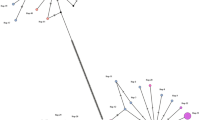Abstract
For elucidation of the taxonomic status of the Japanese Fasciola species, whole mitochondrial DNA of Fasciola hepatica from Australia, F. gigantica from Malaysia, and Fasciola sp. from Japan was digested with three four-base-cutting endonucleases: HinfI, MspI, and RsaI. The resulting digestion patterns showed that for each enzyme there were some bands specific for each geographical isolate and that the Japanese Fasciola sp. shared more bands with F. gigantica than with F. hepatica. Nucleotide sequences of two regions, the second internal transcribed spacer (ITS2) of the nuclear ribosomal RNA cluster and mitochondrial cytochrome c oxidase subunit I (COI), were also compared among them. The ITS2 sequence was highly conserved among the three isolates. F. gigantica and the Japanese Fasciola sp. were identical, but they differed from the Australian F. hepatica at six sites, one of which was a deletion. The COI sequence was less conserved but implied a similar relationship between the isolates. There seems no reason to regard the Japanese Fasciola sp. as anything other than a strain of F. gigantica.
Similar content being viewed by others
Author information
Authors and Affiliations
Additional information
Received: 5 August 1996 / Accepted: 15 October 1996
Rights and permissions
About this article
Cite this article
Hashimoto, K., Watanobe, T., Liu, C. et al. Mitochondrial DNA and nuclear DNA indicate that the Japanese Fasciola species is F. gigantica . Parasitol Res 83, 220–225 (1997). https://doi.org/10.1007/s004360050237
Issue Date:
DOI: https://doi.org/10.1007/s004360050237




